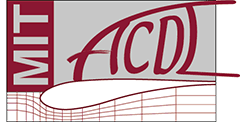Abstract: Mesh adaptation considers an optimization problem (to minimize an error of interest) with the mesh as a discrete(connectivity)-continuous(vertices) variable. This is generally untractable, but the problem can be relaxed by considering instead metric fields as the design variable. Metric fields define meshes through the unit mesh definition. An infinity of unit meshes in a given metric field may exist, but they share relevant invariants (lengths, quadratic form evaluations) that guarantee desired error bounds. The optimal metric field for the adaptation problem can then even be computed analytically (then approximated from numerical data) in some cases (e.g. multi-scale metrics).
High-order or Bézier meshes are comprised of elements defined by polynomial mappings from the barycentric/reference domain. Traditionally, this is used to better fit the mesh to the domain boundary, as it's been proved as far back as the 70s (for elliptic problems) and the 80s (hyperbolic) that straight-sided meshes hamper convergence speed of high-order numerical schemes if the exact boundary is curved. These meshes also offer additional degrees of freedom (interior control points) to improve error, but this has not been explored extensively yet, much less from a continuous mesh standpoint.
The unit mesh definition is typically only considered for linear meshes, although generalizations to high-order elements of quality measures assimilable to indicators of unitness (when minimized, elements are unit up to scale) have been considered as curvature drivers, though with no link to error estimation. The extension of MOESS to high-order meshes generalizes a posteriori metric-based estimates through allowing the surrogate error model to consider pointwise Jacobian matrices, but traditional a priori error estimates such as on interpolation error have not been generalized, nor have h-adaptation techniques.
Beyond these theoretical considerations, it remains to devise algorithms to robustly produce high-order meshes with curved boundary and metric-based curvature in a timely manner. The main issue is that of geometric validity, as elements should have everywhere invertible mappings. Most methods to generate curved meshes work under the assumption that the ideal mesh is straight in the interior, and correct through surface curvature propagation techniques. This is no longer adequate when the entire mesh must be curved in a non-uniform manner.
This talk presents these issues with particular attention to a high-order mesh curvature scheme as well as a new method to correct high-order meshes. The latter is based on recasting the maximization of the minimum Jacobian determinant as a linear program which can be solved very efficiently, though restricted to edge shells (tetrahedra sharing an edge). It is then globalized by dynamic iterative smoothing. An a priori interpolation error estimate is derived on curved meshes, which may provide leads on more general surrogate error models, as well as the proper definition of unitness (already in use in high-order MOESS). 3D numerical results of a posteriori curving, either traditional surface-dominant or metric-based, on complex geometries are presented. In particular, an adapted mesh of the C608 low-boom prototype with 20M tetrahedra can be curved to validity after surface projection in under 10s on a laptop.
Bio: I am a postdoctoral Associate at MIT working with David Darmofal and Marshall Galbraith since April 1st. I am a recent PhD graduate, having conducted my doctorate at Inria Saclay in France under the direction of Adrien Loseille and Frédéric Alauzet of the GAMMA team. The focus of this PhD was to extend adaptation using the continuous mesh framework (mesh-metric duality) to high-order (polynomial Bézier) meshes. I had previously graduated from the AMS (Analyse, Modélisation, Simulation) Master's in Applied Mathematics at Paris-Saclay.

